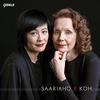|
Back
12/05/2018
"Saariaho X Koh"
Kaija Saariaho: Tocar – Cloud Trio – Light and Matter – Aure – Graal théâtre
Jennifer Koh (violin), Hsin-Yun Huang (viola), Wilhelmina Smith (cello), Anssi Karttunen (cello), Nicolas Hodges (piano), Curtis 20/21 Ensemble, Conner Gray Covington (conductor)
Recording: Miriam and Robert Gould Rehearsal Hall, Philadelphia, PA (October 2016), Academy of Arts and Letters, New York, NY (December 2016), Studios Ferber, Paris, France (November 2017) – 68’06
Cedille CDR 90000 183 – Booklet in English

   
Kaija Saariaho’s seductive, mysterious music has rightly earned the advocacy of a long list of stellar musicians, including several strong discs of her chamber music. In this collection from the stalwart Chicago label Cedille, violinist Jennifer Koh confidently joins the fray and easily equals those who have come before. This collection of mostly-recent Saariaho works that provides an excellent overview of the composer’s voice and of Koh’s virtuosity.
The earliest work on the disc, Graal théâtre, comes from 1994 and is the piece that brought Koh and Saariaho together. Composed for Gidon Kremer (who recorded the version with “full orchestra"), the piece is a bona fide violin concerto in two movements, complete with several virtuosic cadenzas for the soloist. Saariaho reworked the accompaniment of the original for a smaller chamber orchestra, which is the version heard here. Although an earlier work, it is the most dissonant and gestural on the disc. This shouldn’t scare away listeners, though; Saariaho’s language can be gritty, but there is always a riveting timbral sheen to the music, even when Koh is scratching the violin’s strings with extreme bow pressure or chromatic clusters are accumulating in the ensemble. The young musicians of the Curtis 20/21 Ensemble manage the rhythmic and timbral complexities of the score with ease, expertly coordinated by Conner Gray Covington. The larger ensemble, lengthier movements, and increased drama inherent in the concerto genre make this an excellent finale.
Smaller chamber works from the past decade precede the concerto. These works share a warmer, more lyrical musical language, still replete with Saariaho’s imaginative orchestration that often features glistening, imaginative use of ponticello and harmonics. Tocar, composed in 2010 as the compulsory piece for the Jean Sibelius Competition, and Light and Matter, from 2014, both feature piano. Saariaho explores timbral possibilities of the instrument less than the strings, giving these two works a darker, more grounded feel. Nicolas Hodges is at the keyboard for both works, and he and Koh are joined by cellist Anssi Karttunen in Light and Matter.
Tocar begins as a standard slow-fast movement, and it builds to a crushing climax before a brief disintegration. This straightforward structural conceit is performed with excellent forward momentum by Koh and Hodges; the short movement provides an excellent summary of Saariaho’s recent language, and in the fast movement even gives a nod to the dense keyboard harmonies of Messiaen and syncopated rhythms of 1920s French jazz.
Light and Matter is a more complex structure, its 14-minute expanse meant to represent a New York City park in changing light. The framing device of a unison C provides guidance to the listener, while Saariaho deftly passes motives among each of the three players. It is a substantial, important addition to the piano trio repertoire.
The two strings-only works allow Saariaho to engage in incredible feats of chiaroscuro. The brief Aure is a memorial for Henri Dutilleux and expands upon a short motive from the French composer’s ingenious The Shadows of Time. The haunting motive—sung in the Dutilleux work by a solo child to the Anne Frank text “Why us, why the star?”—is woven into an amazingly rich tapestry of music. Saariaho’s ability to draw such a variety of textures from a violin-cello duo is baffling. Karttunen once again joins Koh, and the duo perform the work expertly.
Cloud Trio is a true masterpiece that, I predict, will become a standard work in the string trio canon. The four-movement slow-fast-fast-slow structure is compelling, and the soundworld conjured by Saariaho is intoxicating. The opening three movements gain momentum as tempos increase; the music is never “fast”, but it has a dark, pulsing energy. The fourth movement is a five-minute soulful exploration of the trio and the shadowy nature of clouds, and reveals some of the most memorable lyrical writing that has come from Saariaho’s pen. The all-female trifecta of perormers—Koh, Hsin-Yun Huang, and Wilhelmina Smith—play with gorgeous blend and appropriate fierceness. One wishes they would record more of the repertoire.
The recorded sound for all works is quite intimate, notably in the works with piano, which almost feels as if we are seated inside the ensemble. The balance in Graal théâtre spotlights the soloist a bit more than Kremer’s recording, but it never feels off. An informative collection of program notes by Anne Leilehua Lanzilotti, including many wonderful quotes from Saariaho herself, are complemented by complete bios of all performers for an excellent production. Highly recommended to lovers of Saariaho, Koh and great chamber music!
Marcus Karl Maroney
|